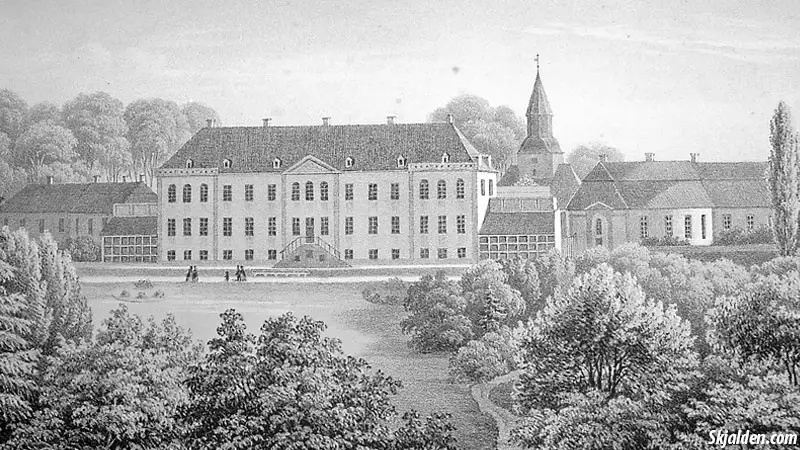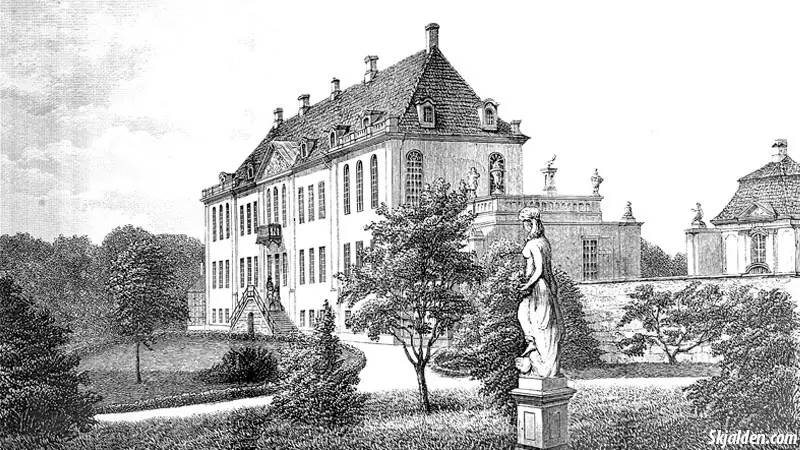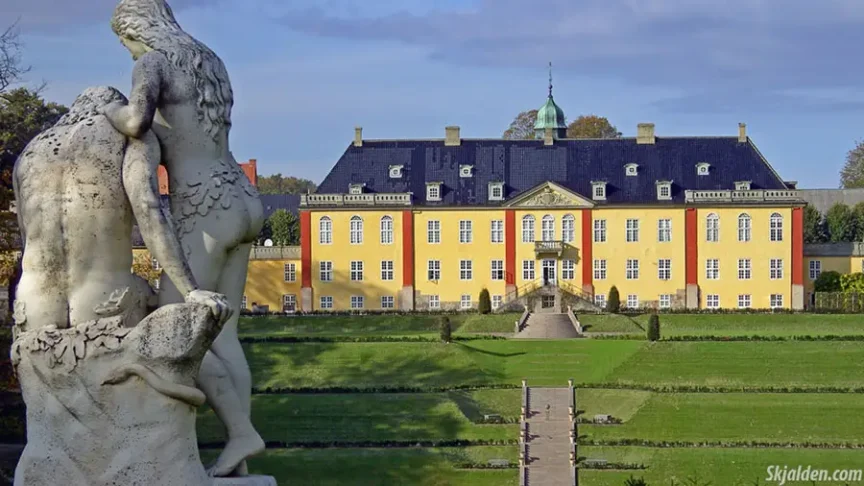Ledreborg Castle, originally known as Lejregård, was built from 1740 to 1745 by Johan Ludvig Holstein, a key figure in King Christian VI’s Danish Chancellery. Located near Lejre in Zealand, Denmark, this castle has been more than just a home; it’s been a significant part of Danish history for over 250 years.
Constructed during a period rich in cultural and architectural development, Ledreborg Castle stands as a remarkable example of the architectural style and societal norms of the 18th century. Its creation was not merely an act of building a residence but also a declaration of status, power, and artistic sensibility in a rapidly evolving Denmark.
The Creation of Ledreborg Castle
The story of Ledreborg Castle (Danish: Ledreborg Slot) begins with Johan Ludvig Holstein, a figure of significant stature in Danish history. His role as a central figure in the court of King Christian VI was crucial not only in the governance of Denmark but also in the cultural and architectural landscape of the period. Holstein’s influence at the Danish court was not limited to political decisions; it also extended to his personal endeavors, of which the transformation of Lejregård into Ledreborg Castle is a prime example.
Johan Ludvig Holstein’s journey to prominence began with his astute political skills and strategic alliances. His adeptness in navigating the complexities of court politics granted him substantial influence and wealth. It was this position of power and his vision for a grand estate that led to the creation of Ledreborg Castle. The transformation of the existing Lejregård into the grandeur of Ledreborg was a project of both passion and prestige. Holstein envisioned a residence that would reflect his status and the growing importance of his family in Danish society.
The construction of Ledreborg Castle was a considerable undertaking, requiring extensive planning, resources, and artistic direction. Holstein sought the expertise of renowned architects and designers of the era to realize his vision. The castle was designed to be more than a mere residence; it was to be a manifestation of Holstein’s achievements and status. Every aspect of the castle, from its striking facade to the intricate interiors, was meticulously planned to showcase elegance, luxury, and the cultural sophistication of its owner.
In converting Lejregård to Ledreborg Castle, Holstein was not just creating a home for his family but also a symbol of his legacy. He intended the castle to be a physical representation of his journey from a nobleman to a key political figure in Danish history. The architecture of the castle, with its blend of traditional Danish and contemporary European styles, was a statement of his refined taste and his connection to the broader cultural currents of Europe.
The completion of Ledreborg Castle marked a significant milestone in Holstein’s life and in the architectural history of Denmark. It stood as a symbol of his ambition, serving as a beacon of cultural and architectural innovation. The castle quickly became renowned for its beauty and its role as a center for intellectual and cultural activities, attracting prominent figures from various spheres.
Moreover, the strategic location of Ledreborg Castle, near the ancient town of Lejre, was a deliberate choice by Holstein. This location imbued the castle with a sense of historical continuity, linking Holstein’s contemporary achievements with Denmark’s rich past. The proximity to Lejre, with its historical significance, added depth to the castle’s stature as a new but important landmark in Danish history.

Architectural Evolution of Ledreborg Castle
The architectural journey of Ledreborg Castle is as rich and varied as its history. Its original structure, rooted in the mid-17th century, has undergone numerous transformations, each phase adding to its grandeur and historical significance. The evolution of the castle’s architecture is an example of the changing styles and tastes over the centuries, as well as the technological advancements in building and design.
The original structure of Ledreborg Castle, while grand in its own right, was significantly expanded and enhanced by two of the era’s most prominent architects: Johan Cornelius Krieger and Niels Eigtved. These architects were not just builders; they were artists who brought their visions and styles to the castle, transforming it into a masterpiece of architectural design.
Johan Cornelius Krieger’s role in the evolution of Ledreborg Castle cannot be overstated. His architectural genius is evident in the major extensions he designed. Krieger was tasked with expanding the castle to accommodate the growing needs and aspirations of the Holstein family. His work included the addition of a chapel, a significant architectural and spiritual addition to the estate. This chapel was not just a place of worship but also a symbol of the family’s status and their commitment to their faith and community.
Another significant contribution by Krieger was the grand staircase, a feature that combined functionality with artistic beauty. This staircase was not merely a means of moving between floors; it was a statement piece, showcasing the elegance and grandeur of the castle. The design and craftsmanship of the staircase reflected the opulent style of the period and added to the overall aesthetic appeal of the interior.
Niels Eigtved’s contributions to Ledreborg Castle brought a different yet complementary style to the estate. His design of the Rokoko banqueting hall is particularly noteworthy. This hall, with its exquisite design and intricate details, became the centerpiece of the castle’s social and cultural life. The Rokoko style, characterized by its lightness, elegance, and use of curved forms, was perfectly suited to a space meant for entertainment and celebration. Eigtved’s design incorporated artistic elements that were both visually stunning and representative of the cultural trends of the time.
The architectural evolution of Ledreborg Castle also included other enhancements such as the development of the gardens and the outer facades. Each change and addition to the castle was carefully planned and executed, ensuring that the new elements blended seamlessly with the existing structure. The architects and craftsmen involved in these projects were masters of their trade, and their work reflects a deep understanding of both the aesthetic and functional aspects of building design.
Throughout its architectural evolution, Ledreborg Castle maintained a balance between preserving its historical essence and embracing new styles and technologies. This evolution was not just about adding more space or decorative elements; it was about creating a living, breathing structure that reflected the changing times and the enduring legacy of the Holstein family.
Today, the architectural splendor of Ledreborg Castle stands as a physical representation of the rich past of Danish architectural history. From its initial construction in the mid-17th century to its continuous enhancements over the years, the castle has grown and adapted, mirroring the artistic, cultural, and technological advancements of each era. This architectural journey makes Ledreborg Castle not only a significant historical monument but also a showcase of the evolution of architectural art and design in Denmark.

The Castle’s Magnificent Gardens
The gardens of Ledreborg Castle are a vital and vibrant part of its legacy, mirroring the castle’s architectural grandeur in its design and upkeep. Originally laid out by Johan Cornelius Krieger, these gardens are a splendid example of Baroque landscape art, a style that was as much about showcasing power and prestige as it was about beauty and nature.
Krieger’s initial design of the gardens was a masterful blend of precision, symmetry, and artistic expression typical of the Baroque era. In this style, gardens were not merely an afterthought but an integral part of the estate, reflecting the status and taste of the owner. Krieger envisioned the gardens as an extension of the castle itself, with each hedge, pathway, and fountain carefully planned to create a harmonious and impressive whole.
Over the centuries, the gardens at Ledreborg Castle have been meticulously maintained and thoughtfully restored, ensuring that Krieger’s original vision continues to shine through. Each generation of caretakers and gardeners has contributed to the preservation and enhancement of these magnificent gardens. The careful restoration work has been particularly important in preserving the historical integrity of the gardens while allowing for the incorporation of new elements and styles.
The evolution of the gardens also reflects broader changes in landscape design over the centuries. From the structured and formal designs of the Baroque period to the more natural and relaxed styles of later eras, the gardens have adapted and grown. This adaptability has allowed the gardens to remain relevant and beautiful, mirroring the changes in gardening trends and techniques.
A walk through the gardens of Ledreborg Castle is like a journey through time. The perfectly manicured hedges, the ornate fountains, and the strategically placed sculptures all tell the story of a bygone era of opulence and artistry. The gardens serve not only as a tranquil retreat but also as a living museum of landscape design, offering insights into the historical and cultural context in which they were created.
Ledreborg Castle in Modern Times
In the ever-changing landscape of the 21st century, Ledreborg Castle has skillfully adapted, balancing its rich historical legacy with the demands and interests of modern society. Today, the castle is not just a relic of the past but a vibrant, functional part of Denmark’s cultural and social life. It has become a favored venue for a wide range of events, blending its historical ambiance with contemporary needs.
The castle’s transformation into a hub for events and gatherings is an example of its versatility and timelessness. It regularly hosts conferences, seminars, and cultural gatherings, providing a unique setting that combines the elegance of the past with modern amenities. These events range from academic symposiums and corporate retreats to art exhibitions and literary festivals, each finding a fitting backdrop in the castle’s historic halls and rooms.
One of the most notable events at Ledreborg Castle is the annual concert series performed by the Danish National Chamber Orchestra. These concerts are a perfect illustration of how the castle bridges history and modernity. Set against the backdrop of the castle’s stunning architecture and grounds, the music resonates not just with notes but with centuries of history, creating an experience that is both enriching and enchanting.
Welcoming the Public
Ledreborg Castle has embraced its role as a public cultural asset with open arms. The castle is not just a preserved historical site; it is a dynamic space that invites exploration and interaction. The guided tours offered by the castle are a journey through time, revealing the rich tapestry of its history, art, and architecture. These tours allow visitors to step into the world of the Holstein family and experience the splendor and stories contained within the castle walls.
Inside the castle, each room and hall is a treasure trove of history, housing a collection of original furnishings, artworks, and artifacts that speak volumes about the lives and times of its former inhabitants. The knowledgeable guides provide insights into the castle’s past, bringing to life the stories and events that have shaped it.
The castle’s engagement with the public extends to its magnificent gardens and surrounding landscapes. These areas offer a serene and beautiful environment for visitors to explore and enjoy. The gardens, with their meticulously maintained hedges, vibrant flower beds, and historic sculptures, are a delight for both garden enthusiasts and casual visitors. They provide a peaceful retreat from the hustle and bustle of modern life, allowing guests to immerse themselves in the beauty and tranquility of nature.
Ledreborg Castle’s adaptation to modern times has been a journey of balancing preservation with innovation. By opening its doors to the public and hosting a variety of events, the castle has ensured that its historical significance is not just remembered but experienced and appreciated by new generations. It stands today not only as a monument to Denmark’s past but also as an active participant in its cultural present and future. See there opening hours here.
Photo credit: Bococo
